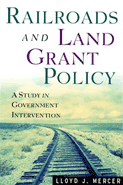|
|
|
|
||||||

|
Railroads and Land Grant Policy
By Lloyd J. Mercer 2002/11 - Beard Books 1587981548 - Paperback - Reprint - 317 pp. US$34.95 Railroad aficionados and students of American 19th century economy will learn much about the economic rationality of the land grant policy with regard to the railroad behemoths that criss-crossed our country. Publisher Comments This noteworthy book deals with federal land grants made from the public domain to a number of states to build transcontinental railroads during the nineteenth century. The railroad land grants were a significant intervention by the government in the operation of the economy and are frequently viewed as a simple matter of government gifts to business. This study aims to refute the legend that these land grants to private companies benefited the companies more than society as a whole. It also attempts to illuminate the effect of the railroad land grants on economic efficiency and to put the income and wealth distribution of the railroad land grants in perspective. From Choice Mercer (University of California, Santa Barbara) focuses his attention on seven western carriers--the Central Pacific, Union Pacific, Texas & Pacific, Santa Fe, Northern Pacific, Great Northern, and Canadian Pacific--that received various amounts of public real estate. These companies generally constructed lines through unsettled regions and used the 'building ahead of demand' notion as an effective argument for public largess. But, according to Mercer,this was not sufficient reason for the massive land grant subsidy. Indeed, the presence of financial backing led to excess construction." From R.G. Rennie - Choice The first work to explore carefully the economic rationality of a monumental episode in federal support to the private business sector. . . . Since much of this book is an empirical evaluation of the land grant issue, the generalreader will find it too detailed and complicated. Yet for the advanced student of American business history, this study should be required reading. The nine appendixes, totaling 112 pages, are highly technical, although they are a valuable and convincing dimension of the Mercer thesis. From Peter J. George - Business History Review Professor Mercer concludes that, 'On balance, the land grant policy was good for society in terms of economic efficiency.' His conclusion is ably supported in this book. Although not written with much dramatic flavour and flourish, Professor Mercer's book clearly states his hypotheses and his results are carefully and cogently argued. It represents the definitive study of the economic efficiency of the railroad land grant system. From Book News: Mercer (economics, U. of California at Santa Barbara) assesses the economic efficiency of the land grant subsidies to the large U.S. railroad systems in the 19th century. He limits his analysis to the relationship of the social and private rates of return on investment in the land grant railroads to the opportunity costs of capital. He argues that, for five of the seven systems studies, it was beneficial to the economy to transfer public goods to the railroad owners. Annotation (c)2003 Book News, Inc., Portland, OR
Other Beard Books by Lloyd J. Mercer:
|
|||||||||||||||||||||||||||||||||||||||||||||||||||||||||||||||||||||||||||||||||||||||||||||||||||||||||||||||||||||||||||||||||||
|
|
|
home
| about us
| contact us
| related
sites |